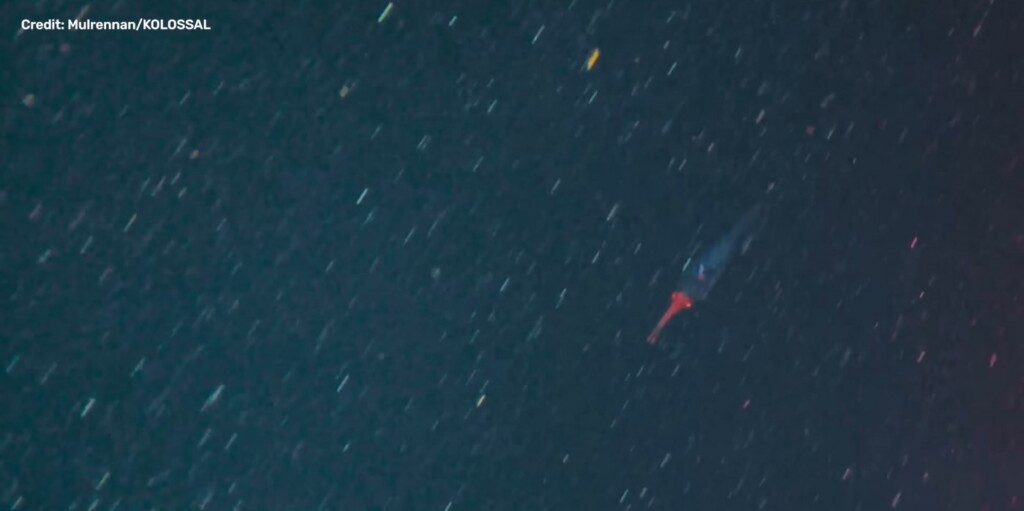 credit – Matthew Mulrennan, Kolossal
credit – Matthew Mulrennan, KolossalLast year, a group of scientists attempting to capture footage of a colossal squid, the largest invertebrate on Earth, in its natural habitat may have hooked their prize when one of their underwater cameras captured a juvenile glass squid swimming by.
Colossal squids are members of the glass squid family, and so appear transparent to the eye—not that any eye has ever been laid on one in its day-to-day life. However, in the high-definition footage captured by the researchers, the vermillion tentacles and faint blue bioluminescence narrow down the list of potential species considerably.
In the epitomization of the phrase anti-climactic, the ‘colossal squid' was a 12-centimeter-long juvenile, but because the expedition was privately funded, it gave the team immediate impotice to return to the Antarctic waters and search for longer, and at greater depths.
Kolossal Expedition leader Matthew Mulrennan was working on the Antarctic tourist boat Ocean Endeavour where 200 tourists shared quarters with him and his team between December 2022 and April 2023.
Hakai Magazine reports that the curiosity and support of the tourists was needed motivational drive to keep the team from flagging in their endless monitoring of the frigid waters below their vessel.
“We’d put the camera in the water at midnight or 1:00 a.m., be up until 4:00 or 5:00 a.m., and then have to get up at 6:00 or 7:00 a.m.,” Jennifer Herbig, a doctoral candidate at Memorial University in Newfoundland, told the coastal focused magazine.
In total the marine biologists captured 62 hours of footage, broken up by the constant efforts to unsnag the camera lines from sea ice around the South Shetland and South Georgian islands.
Then, paydirt—a tiny candidate for their colossal quarry swam by, although it could have been another large glass squid called Galiteuthis glacialis. The footage was sent to New Zealand’s Auckland University of Technology, a country in whose territorial waters the only live adult colossal squid was ever fished out of the depths—a female in 2007 that was over 12 feet long and closing in on 1,000 pounds.
“The two known Cranchiidae taxa seen in the Antarctic are Galiteuthis glacialis and Mesonychoteuthis hamiltoni,” Dr. Aaron Evans, who studies the Cranchiidae family and has been peer reviewing the footage, told IFL Science.
“The squid seen here could belong to different life stages of either of those taxa—and is an exciting example of wild cranchiid behavior, as I cannot think of existing video footage of either of those squid in their natural environment.”
NEWS FROM THE BENTHIC ZONE: More Than 100 New Species of Stunning Marine Life Found Near Underwater Mountains (LOOK)
Without bones or cartilage to support its massive bulk, the colossal squid relies on the intense oceanic pressures of its bathypelagic home to keep itself together, and simply falls apart at sea level. Almost all of what was known about the animal prior to the 2007 discovery came from bits and pieces recovered from the stomachs of sperm whales, the squid's natural predator.
For this reason, studying them in their natural habitat is the only chance to unravel the mystery of an animal that is both the largest cephalopod and the largest invertebrate on Earth.
OTHER DEEP-SEA SQUID VIDEOS: Rare Deep Sea Squid with ‘Headlights’ Captured on Video–Mistaking the Camera for Food–WATCH
Little if anything is known about the colossal squid. It's believed they're ambush predators, like most hunters in the lightless depths. They have the largest eyes in the animal kingdom—12 to 16 inches in diameter, or about the size of a volleyball, which is believed to give them best-in-class abilities to see through the murk, identify bioluminescent creatures, and detect sperm whales from a distance.
Kolossal and Mulrennan are planning to return in November to keep searching. They're planning to bring more cameras and longer camera cables, and maybe also equipment for taking DNA samples in the water so they can be sure of their discovery if they make any bigger, potentially colossal ones.
WATCH the squid swim by at 2:23 seconds in the video below…
SHARE This Fascinating Discovery And Excellent Scientific Work With Your Friends…
Source link

